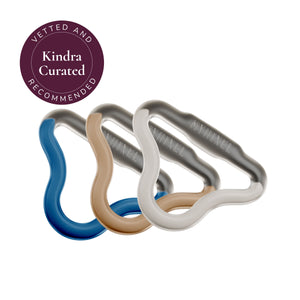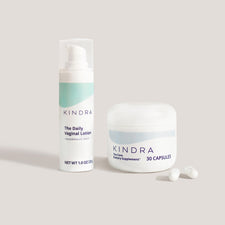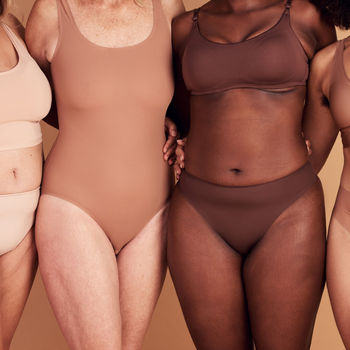Nails are the most underrated part of the body. They’re strong, durable, and constantly growing and renewing themselves, no matter how many times they’re cut down to size. (Brené Brown, who?)
But if you’re going through menopause, you might have noticed some major changes in your nails — thinness, split ends, breakage, you name it. Unfortunately, brittle nails are a symptom of menopause, albeit one of the less obvious ones (ahem, hot flash). Why that is, experts aren’t totally sure, but here’s what is known about menopause-related brittle nails, and how to get yours manicure-ready in no time.
What Causes Brittle Nails During Menopause?
Nails are considered “brittle” when the nail plate (the pink part of the nail) becomes weak and fragile and may split, crumble, or flake as a result. In dermatologist speak, this condition is called Brittle Nail Syndrome (BNS), and an estimated 20 percent of the population experiences it. Women are twice as likely to experience BNS compared to men, with women over the age of 50 being particularly at risk.
If you have brittle nails, you might have vertical ridges running up and down your fingernails. (These ridges might even split or crack, depending on how brittle your nails are.) Your nails might also peel and flake like sunburnt skin, or have tiny flecks of white all over the nail.
You can get brittle nails for a number of different reasons. Constantly washing and drying your hands (say, if you’re a teacher, doctor, or just trying to practice good hygiene during a pandemic) can mess with your nail structure and make them brittle. Leaving nail polish on for too long, going overboard on nail treatments, having overly-long nails that break, or doing manicures incorrectly can also damage your nails and leave them brittle. Common skin conditions like psoriasis and eczema can also contribute to brittle nails, as can fungal nail infections. Constant contact with chemicals (like detergents or cleaning agents) can also trigger brittle nails.
Frustratingly, the most common type of nail brittleness is “idiopathic,” which is science speak for “it just randomly happens.”
Unfortunately, our understanding of the relationship between brittle and menopause is almost non-existent because researchers haven’t yet compared the instances of brittle nails in premenopausal versus menopausal women. Our best guesses right now: Some aspects of women’s nail structure are weaker than men’s, which could partly explain why women are more likely to deal with brittle nails than men. While everyone’s nails get duller and more brittle with age, post-menopausal women tend to have less of a key lipid in their nails that maintains nail structure and health. Some researchers believe that the hormonal changes that begin in perimenopause may also contribute to brittle nails—and, certainly, many anecdotal accounts from menopausal women appear to confirm this—but no scientific link has been made… at least, not yet.
Remedies for Brittle Nails
Brittle nails are largely treated with supplements and lifestyle changes. Here are some of the most commonly recommended treatment options:
Related Nail Symptoms During Menopause
While there are no other nail symptoms in menopause that have been widely studied, you may notice other changes in your skin and hair during the menopause transition. As your natural estrogen levels start to decrease, you start to retain less moisture in your skin, and you may notice dark spots, dry or flaky patches of skin, and/or hair thinning.
If any of these symptoms crop up, make sure to talk to your doctor about potential ways to lessen the burden of these exterior signs of menopause.
When to See a Doctor for Your Brittle Nails
The American Academy of Dermatology Association (AAD) says you should should see a dermatologist if your nails:
- Change color (turn white, for example, or develop dark spots or lines)
- Change texture (you start seeing pits or thick grooves or ridges)
- Change shape
- Stop growing
- Bleed
- Separate from the surrounding skin
- Swell
These symptoms could be a sign of something more serious going on. (Completely white nails, for example, is a sign of anemia.) While the transformation may be completely benign, erring on the side of caution is the way to go. So start a dialogue with your MD if you notice that your nails don’t look quite right.
A final note
We’ll go bad news, good news—okay? The bad news: Researchers don’t yet know a lot about why menopause may wreak havoc on your nails. The good news: There are plenty of remedies you can try to strengthen them. Time to put this frustrating nail issue to bed.
Sources:
Brosche, T. et. al., Aging (Milano), Age-Associated Changes in Integral Cholesterol and Cholesterol Sulfate Concentrations in Human Scalp Hair and Finger Nail Clippings, April 2001.
Chessa, M. et al., Dermatology and Therapy, Pathogenesis, Clinical Signs and Treatment Recommendations in Brittle Nails: A Review, November 2019.
Cleveland Clinic, Brittle Nails? 5 Tricks to Keep Your Tips in Top Form, June 2020.
Cleveland Clinic, Here’s How Menopause Changes Your Skin and Hair, February 2021.
Duarte, G. et. al., Cutis, Skin Disorders During Menopause, February 2016.
Food and Drug Administration, UPDATE: The FDA Warns That Biotin May Interfere With Lab Tests: FDA Safety Communication, November 2019.
Gequelim, G. et. al,, Anais Brasileiros De Dermatologia, Perception of Brittle Nails in Dermatologic Patients: A Cross-Sectional Study, November to December 2013.
Hochman, L., , Cutis, Brittle nails: response to daily biotin supplementation, April 1993
National Library of Medicine, InformedHealth.org, Structure of the Nails, June 2018.
National Library of Medicine, MedlinePlus, Aging Changes in Nails, July 2020.
The American Academy of Dermatology Association, 12 Nail Changes a Dermatologist Should Examine, Undated.
Van de Kerkhof, P. et al., Journal of the American Academy of Dermatology, Brittle Nail Syndrome: A Pathogenesis-Based Approach With a Proposed Grading System, October 2005.













